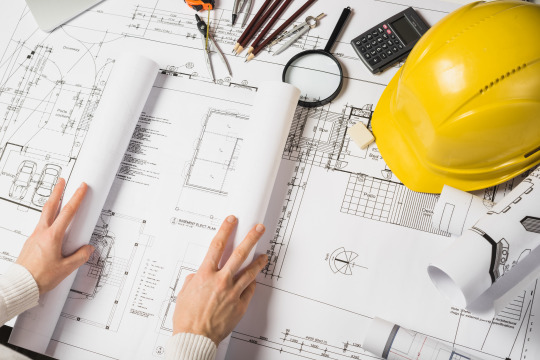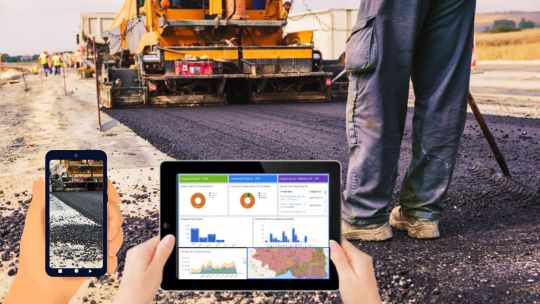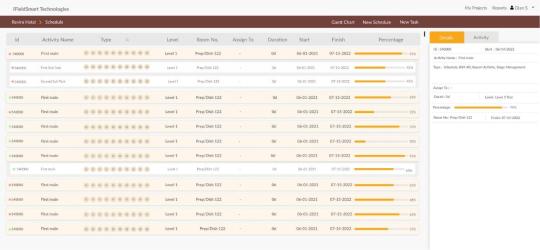#construction management tools
Explore tagged Tumblr posts
Text
The Role of As-Built Drawings in Quality Assurance and Quality Control
The Role of As-Built Drawings in Quality Assurance and Quality Control
As-built drawings are accurate and exhaustive construction documents that portray the final state of construction. Validation of construction accuracy, design specifications compliance, error detection, and documenting modifications during construction improve project quality and reduce risks. This leads to greater quality assurance and control for construction projects.

Introduction
Definition of As-Built Drawings:
As-Built documentation is a conclusive set of drawings that illustrate accurate configuration, specifications, and dimensions of a construction project after completion. As-Built drawings support architects, contractors, building owners, engineers, and facilities managers record changes or deviations during various construction phases, and also serve as a digital repository for maintenance and operations.
Importance of Quality Assurance and Quality Control in Construction Projects
Quality assurance and control within construction projects is critical to ensure structural integrity, client satisfaction, compliance to regulations, risk mitigation, lower rework, and expedited project completion within planned costs. ‘
While we understand the importance of As-Built drawings in construction, they also pose roadblocks when it comes to their creation and management leading to issues in quality control and quality assurance. Traditional processes and tools to manage As-Built drawings are not cut-out for modern construction causing inaccuracies, silos, documentation issues, erroneous communication, and non-compliance to building codes and regulations.

Image source: https://www.bigrentz.com/blog/as-built-drawings
Understanding the Role of As-Built Drawings
Definition and Purpose :
Represents a completed project with accurate dimensions, material use, and documented modifications during the building process for renovations, maintenance, and expansion.
Differentiating As-Built Drawings from Original Plans
Onsite Reality vs Planned Design: As-built drawings illustrate deviations or changes while original plans showcase intended design before construction begins.
Accuracy vs Presumptions: As-built drawings record real-world conditions after construction in comparison to original design that serve as a conceptual blueprint.
Documentation Changes: As-Built drawings record the final state with changes or adjustments performed during construction vs original plans serve as static documentation to navigate the construction process.
Significance in the Construction Lifecycle
Validate accuracy of built elements after completion vs original design intent
Document modifications or revisions to track project evolution
Offer accurate and clear information for repairs, renovations, and maintenance
Ensure legal compliance based on building codes, zoning ordinances, etc.
Create a precise illustration of completed construction to reduce risks, rework, and disputes.
Excellent asset management for facilities managers and owners to make informed decisions.
Provide a detailed historical reference into building processes, materials used, and structural analysis.
As-Built Drawings in Quality Assurance
Ensuring Compliance with Design Specifications:
As-Built drawings are crucial in quality assurance as they verify built elements align with planned design specs. As-Built documentation captures modifications or deviations during construction to assure conformance with initial plans. They assess project integrity and facilitate efficient quality control workflows.
Verification of Construction Accuracy:
As-Built drawings are significant in validating construction accuracy through quality assurance processes. They document precise measurements and details for constructed elements to ensure alignments with design specifications. With a comprehensive record of the as-built environment, they enable detailed assessments to ascertain construction aligns with planned design.
Identification of Deviations from Initial Plans:
As-Built drawings can identify changes from initial plans. They are meticulous at detailing actual construction vs original design which helps highlight modifications or inconsistencies during the construction process. Precise assessment and a preemptive course of action ensures coordination with project regulations and needs.
As-Built Drawings in Quality Control
Detecting Errors and Deficiencies:
As-Built drawings improve quality control processes through quick detection and resolution of errors and inadequacies. They provide an in-depth record of the As-Built environment for precise comparison against design specifications. Identification of deviations and shortcomings draw-in corrective action to ensure compliance and integrity of a construction project.
Facilitating Inspections and Audits:
As-Built drawings play an essential role in quality control through audits and inspections. They provide an accurate and in-depth record of built elements to allow auditors and inspectors validate compliance with planned design standards. As-Built documentation streamlines the review process to ensure a thorough assessment of regulations and integrity.
Documenting Changes Made During Construction:
As-Built documentation is essential in quality control to document modifications made during construction. They record deviations, modifications, and alterations from proposed plans to deliver an in-depth account of the As-Built environment. As-Built drawings serve as a reference to understand project history and regulatory compliance.

Image source: https://www.purepower.com/blog/importance-of-accurate-as-built-drawings
Challenges in As-Built Drawing Management
Version Control Issues:
Challenges within As-Built drawing revolves around version control problems. Ensuring accuracy and accessibility of up-to-date As-Built drawings amidst recurring revisions can be challenging. Managing clarity within documentation changes while implementing monitoring systems and encouraging collaboration amongst project participants are important strategies to overcome challenges.
Complexity in Updating Drawings:
Complexities in updating As-Built drawings can create obstacles. As construction evolves, including modifications precisely and effectively within drawings is an intricate process. Aligning revisions across multiple disciplines validates consistency including communication updates to resolve errors and manage project documentation.
Accessibility and Collaboration:
Problems within As-Built drawing management stems from accessibility and collaboration issues. Ensuring As-Built drawings are accessible to every project participant is complex and produces challenges. Overcoming geographical boundaries, deploying user-friendly tools, and encouraging transparent communication channels are vital to improve accessibility and foster streamlined communication.
Importance of As-Built Drawings Management Software
Streamlining Drawing Updates and Revisions:
As-Built drawings software plays an important role in improving drawings revision and updates through a centralized platform for version control and effective collaboration. It expedites the process to augment accuracy, ensure consistency, save time and resources to maintain the validity of project documentation.
Enhancing Collaboration amongst Stakeholders:
As-Built drawings management software improves collaboration between stakeholders to provide a centralized platform for real-time access and communication. It fosters information sharing, drives quick feedback, and fuels clarity for the entire project lifecycle. This helps teamwork, lowers ambiguities, and makes sure everyone is aligned toward common goals.
Providing Centralized Access to Drawing Repositories:
As-Built drawing software is important for providing unified access to As-Built drawing repositories. It consolidates As-Built documentation on a single dashboard for every project participant to access, save, review, and update As-Built drawings quickly and efficiently. This approach fuels productivity, organization, and reduces the risk of errors and ambiguities.
Benefits of Utilizing As-Built Drawings Management Software
Time Savings:
Using cloud-based As-Built drawings management software cuts down on manual tasks like updating, sharing, and keeping track of changes. With easy access and collaboration tools, teams can work faster, saving lots of time on different projects.
Cost Reduction:
Switching to cloud-based software saves money by getting rid of the need for physical storage and lessening the use of paper documents. This lowers the costs linked to old-fashioned ways of managing drawings. Plus, it makes work easier and more precise, lowering the chance of expensive mistakes and do-overs.
Enhanced Collaboration:
Cloud-based software makes it easy for everyone involved in a project to work together, no matter where they are. People can see the latest drawings and documents from any device connected to the internet. This helps decisions happen faster, reduces communication problems, and makes the project run more smoothly overall.
Improved Accuracy and Compliance:
Using cloud-based As-Built drawings management software with version control and audit trails guarantees that everyone has the most recent updates. This lowers the chance of mistakes and differences between versions. It also helps meet rules and standards, cutting down on expensive penalties or delays in projects.
Scalability and Flexibility:
Cloud-based solutions can grow with different-sized projects, without needing lots of new equipment. When project sizes change, organizations can easily change how much they pay to match what they need. This makes things more flexible and cheaper in the long run.
Future Trends and Innovations in managing As-Built drawings with AI and ML
Future trends in managing As-Built drawings requires the use of Artificial Intelligence (AI) and Machine Learning (ML) to improve the process. AI algorithms can process large amounts of data within construction projects to detect errors, ambiguities, and drive design optimizations. Machine Learning (ML) algorithms and models help predict construction results, streamline revisions, and enhance accuracy. Furthermore, AI-driven tools provide real-time insights to achieve quick decision-making and refine project efficiency. The integration of AI and ML in As-Built drawing management promises innovation, cost reduction, and elevates construction quality.
Conclusion
To conclude, As-Built drawings are an indispensable tool to ensure validity and acquiescence within construction projects. From verifying accuracy to facilitating audits and inspections, the role of As-Built drawings in quality assurance and control is pivotal. By documenting modifications and driving collaboration, standards can be upheld, errors can be mitigated, and project success can be achieved.
Construction management software is critical to manage As-Built drawings based on its ability to simplify workflows, improve collaboration, and foster accuracy. Centralizing project data, encouraging real-time updates, and facilitating version control improves efficiency and reduces errors to achieve winning project outcomes and client satisfaction.
Visit : www.ifieldsmart.com/as-built-drawings
#as built drawing#as built documentation#as built#as built drawings#As-Built Drawings#As-Built Drawings Software#As-Built Documentation#As-Builts#software#construction management#construction#construction management tools#construction project management#civil industry#civil engineering#civil#building technology#construction management software#construction drawing software
0 notes
Text
Your Mobile-First Construction Management Tool
Fieldwire stands out as a mobile-centric construction management tool, enabling on-site task management, plan viewing, and issue tracking for construction teams.
To know more:
0 notes
Text
#builder#construction management#construction toys blocks toy#construction tools#construction time again#construction software#construction technology#construction site#construction services#construction materials
2 notes
·
View notes
Text
Ah the joys of disabled life, picking through your gigantic fanny pack to see if you can replace it by carrying the tremendous amount of shit you need to survive outside in a bunch of pockets clipped to your belt. 8)
#just blind things#I legit can't bend over when wearing that thing#but I need everything in it for myself and doggo#backpack not viable with my screwed up shoulders 8)#low key considering a tool belt and construction worker suspenders XD#I can manage if enough weight is centered around my hips with shoulder support being more for stability than load bearing#I have a cool hiking day bag but it doesn't have enough pockets and is too bulky alas
2 notes
·
View notes
Text
Transcend Tools To Help Manage Your Capital Programs

Transcend Tools is the only suite of tools to help manage your capital programs and integrate them seamlessly into your facility maintenance management program or complex matrix healthcare facility maintenance and accreditation operations. It has been used on both large and small construction project management created for ALL project shareholders. It is useful for all project shareholders: Owners, Designers, CM/PM’s, General Contractors, Subcontractors, QA/QC Inspectors, HCAI IOR’s, DSA Project Inspectors, Materials Testing Companies, and Special Inspectors.
#construction manager#construction project management#project management for construction software#software#tool#construction estimating software
2 notes
·
View notes
Text
Why the Construction Industry Needs Project Management Software
In today’s fast-paced construction industry, managing multiple projects, coordinating teams, and ensuring timely completion can be challenging. Without the right tools, construction firms risk delays, budget overruns, and miscommunication. This is where project management software for the construction industry plays a vital role. Implementing construction job management software can streamline operations, improve efficiency, and boost profitability.
Benefits of Project Management Software in Construction
Construction companies face unique challenges such as site coordination, resource allocation, compliance requirements, and budget control. A construction project tracking software can address these challenges by offering key benefits such as:
1. Enhanced Project Planning and Scheduling
Construction projects involve multiple tasks, deadlines, and dependencies. Project management software for the construction industry provides scheduling tools that help project managers allocate tasks efficiently, set realistic deadlines, and monitor progress in real time.
2. Better Communication and Collaboration
One of the biggest hurdles in construction is maintaining clear communication among teams. A construction job management software allows seamless communication between on-site workers, contractors, architects, and clients. Features like real-time updates, document sharing, and centralized messaging reduce miscommunication and delays.
3. Real-Time Progress Tracking
Keeping track of construction projects manually can lead to errors and inefficiencies. Construction project tracking software enables real-time monitoring of every phase, ensuring that milestones are met and problems are addressed promptly.
4. Improved Budgeting and Cost Control
Construction projects often go over budget due to unforeseen issues. Using construction job management software, firms can track expenses, manage invoices, and analyze financial reports, ensuring that projects stay within budget.
5. Resource Management Optimization
Efficient use of materials, equipment, and labor is crucial for profitability. Project management software for the construction industry offers tools for resource tracking, helping managers allocate resources effectively and prevent wastage.
Features to Look for in Construction Project Management Software
When selecting a construction job management software, it's essential to consider the following features:
Cloud-Based Accessibility: Enables access to project data from anywhere.
Task Automation: Reduces manual work by automating repetitive tasks.
Integration Capabilities: Seamlessly connects with accounting, procurement, and CRM systems.
Mobile Compatibility: Allows on-site teams to update project status via mobile devices.
Document Management: Provides secure storage for blueprints, contracts, and reports.
How to Choose the Best Construction Project Tracking Software
With numerous options available, selecting the right construction project tracking software depends on your company’s size, project complexity, and budget. Consider software that offers a user-friendly interface, customizable dashboards, and scalable solutions.
Additionally, opt for a vendor that provides excellent customer support and training to ensure smooth adoption. Investing in a reliable project management software for the construction industry can significantly enhance operational efficiency and project outcomes.
Conclusion
The construction industry is highly competitive, and staying ahead requires efficient project management. Implementing construction job management software or construction project tracking software ensures streamlined operations, reduced costs, and better project visibility. Choosing the right software can revolutionize how your construction company manages projects, ultimately leading to greater success and profitability.
By leveraging advanced project management software for the construction industry, companies can mitigate risks, enhance collaboration, and ensure project completion on time and within budget. Now is the time to invest in the right tools and take your construction business to the next level.
#construction project management tools#construction project management software#best construction software#construction project tracking software#construction project management software for small business
0 notes
Text
Streamlining Home Builders' Construction Process: Improve Efficiency & Deliver Results
Learn how to streamline the construction process for home builders. Discover tools and strategies that help manage projects efficiently, reduce delays, optimize workflows, and improve communication, ensuring faster project completion and higher client satisfaction.
Read More

#streamlining home builders' process#efficient construction process#improving home building efficiency#project management for home builders#optimizing home building workflow#reducing delays in construction#home builder project management tools#enhancing home construction efficiency.
0 notes
Text
The Role of Technology in Construction
Technology is changing how the construction industry works. It helps teams plan projects, manage costs, and communicate better.
One big challenge in construction is controlling costs. Staying on budget is hard, but technology makes it easier. Digital tools help track expenses in real-time, reducing mistakes and saving both time and money.
Technology also improves teamwork. Office and site teams can now share updates instantly through online systems. This helps everyone stay informed and fix issues quickly, keeping projects on track.
Tools like Varicon Digital are making a big difference by offering simple solutions for cost management and project tracking. With the right tools, construction becomes faster, easier, and more efficient.

#construction#digital tools#technology#project management#cost management#Digital construction#Construction tools#Varicon digital
0 notes
Text
#AI Factory#AI Cost Optimize#Responsible AI#AI Security#AI in Security#AI Integration Services#AI Proof of Concept#AI Pilot Deployment#AI Production Solutions#AI Innovation Services#AI Implementation Strategy#AI Workflow Automation#AI Operational Efficiency#AI Business Growth Solutions#AI Compliance Services#AI Governance Tools#Ethical AI Implementation#AI Risk Management#AI Regulatory Compliance#AI Model Security#AI Data Privacy#AI Threat Detection#AI Vulnerability Assessment#AI proof of concept tools#End-to-end AI use case platform#AI solution architecture platform#AI POC for medical imaging#AI POC for demand forecasting#Generative AI in product design#AI in construction safety monitoring
0 notes
Text
https://flowrocket.com/finance
#Accounting Advisory Servies USA#Accounting and Bookkeeping services for Business#Accouting and Bookkeeping services USA#Best Auditing Services in USA#Hire Accounting Associates in USA#Hire Audit Supervisor in USA#Hire Bookkeeping Associates in USA#Best CRM Software with Collaboration Tools#CRM solutions for Team Colloboration#Best construction CRM Software#CRM Solutions for Construction Management#Best contract management systems in USA#CRM Software for document management#Best CRM for customer support#CRM for customer service solutions#Customer service software in USA#Agile software development services USA#Business Process Automation USA#IT Consulting Service in USA#Lead management CRM software#Lead tracking CRM software#Best CRM for Financial Services#Financial Services CRM Software#Best GRC Software Solutions in USA#CRM for small businesses#CRM Solutions#Top CRM Software USA#Best CRM Software in USA#Industry Specific CRM Solutions#best free crm for insurance agents
0 notes
Text
Revolutionising Road Construction with Technology: Enhancing Project Management for a Smarter Future
The road construction industry plays a vital role in shaping modern infrastructure, driving economic growth, and ensuring efficient transportation networks. However, it faces persistent challenges, including project delays, safety risks, cost overruns, and inefficient resource management. As construction projects grow in complexity, the need for innovative solutions to boost productivity and efficiency has never been more critical.
Learn more https://www.cyberswift.com/blog/revolutionising-road-construction-with-technology-enhancing-project-management-for-a-smarter-future/

#road construction monitoring software#road project tracking system#csrmonitoringsoftware#road construction progress tracking#gis based road monitoring system#road construction management software#real time road project monitoring#road construction tracking application#construction project tracking system#road project progress monitoring#road asset management software#road construction analytics tools#road infrastructure monitoring system#construction monitoring software for roads#road project planning software#digital road project monitoring system#smart road monitoring solutions#road construction quality monitoring#road project performance tracking#road mapping and monitoring software
0 notes
Text
Efficient Task Management and Scheduling: The Key to Successful Construction Projects
Introduction
Construction projects are complex undertakings that require meticulous planning and construction coordination to ensure they are completed on time, within budget, and to the satisfaction of all stakeholders. With numerous tasks, stakeholders, and resources involved, effective task management and scheduling are crucial for success. In this blog, we will delve into the reasons why task management and scheduling are vital in the construction industry and how they can lead to more efficient and successful construction projects.
Streamlining Workflow: Construction projects involve various tasks, such as site preparation, design, procurement, construction, quality control, and project closeout. These tasks need to be carefully managed to ensure they are completed in the right sequence and with the right resources to avoid delays and costly mistakes. Task management and scheduling enable construction teams to streamline workflow by creating a logical sequence of tasks, allocating resources, and setting deadlines.
Effective task management involves identifying and defining each task, assigning responsibilities to team members, setting deadlines, and tracking progress. With a well-defined task list and clear responsibilities, team members can work cohesively and understand their roles and responsibilities, resulting in better collaboration and productivity. Scheduling helps ensure that tasks are completed on time, with realistic deadlines, and that resources are allocated efficiently. This prevents unnecessary delays and ensures that the project progresses smoothly.
Resource Management: Effective resource management is crucial in construction projects, as resources such as labor, materials, equipment, and finances need to be optimized to keep the project on track. Task management and scheduling allow construction teams to allocate resources efficiently by identifying which tasks require specific resources and when they are needed. This helps avoid overallocation or under allocation of resources, which can lead to costly delays or wasted resources.
Task management and scheduling also help in identifying critical tasks that are essential to the project timeline. By prioritizing these tasks, construction teams can ensure that the necessary resources are allocated to them first, reducing the risk of delays and bottlenecks in the project timeline.
Risk Management: Construction projects are inherently risky, with numerous uncertainties that can impact project timelines and budgets. Task management and scheduling play a critical role in risk management by allowing construction teams to anticipate and mitigate potential risks. By carefully planning and scheduling tasks, construction teams can identify potential risks and develop contingency plans to address them.
For example, if a certain task is dependent on weather conditions, scheduling it during a favorable weather window can mitigate the risk of delays due to inclement weather. Similarly, if a task requires specialized equipment or materials, scheduling it early in the project timeline allows time for procurement and delivery, reducing the risk of delays due to material shortages.
Communication and Coordination: Construction projects involve numerous stakeholders, including clients, contractors, subcontractors, suppliers, and regulatory authorities. Effective communication and coordination among all stakeholders are essential for smooth project execution. Task management and scheduling provide a clear framework for communication and coordination by defining tasks, responsibilities, and deadlines.
With a well-defined task list and schedule, all stakeholders can have a clear understanding of their roles and responsibilities, deadlines, and dependencies. This helps in preventing miscommunication, misunderstandings, and conflicts that can arise due to a lack of clarity or accountability. Effective communication and coordination also allow for timely problem-solving and decision-making, minimizing the impact of unexpected issues on the project timeline and budget.
Efficient Resource Utilization: In construction projects, resources such as labor, materials, and equipment are expensive and limited. Efficient resource utilization is essential to keep the project on budget and ensure profitability. Task management and scheduling helps in optimizing resource utilization by providing visibility into the allocation of resources and identifying areas where resources can be better utilized.
How is iFieldSmart Technologies an important platform for task management and scheduling in construction?
iFieldSmart Technologies is a leading construction management software that provides comprehensive solutions for task management and scheduling, making it an essential platform for efficient construction project execution. Here are some reasons why iFieldSmart Technologies is important for task management and scheduling in construction:
Centralized Task Management: iFieldSmart Technologies provides a centralized platform for managing all construction tasks. Project managers can create, assign, and track tasks in real-time ensuring that all team members have visibility into their responsibilities and deadlines. This helps in streamlining workflow, avoiding miscommunication, and ensuring that tasks are completed on time.
Customizable Task Templates: iFieldSmart Technologies allows project managers to create customizable task templates based on project requirements, standards, and best practices. This ensures consistency in task management across different projects and helps in standardizing processes, leading to increased efficiency and productivity.
Collaborative Task Assignment: iFieldSmart Technologies enables project managers to assign tasks to team members and subcontractors, and track their progress in real-time. Team members can collaborate on tasks, update their status, and communicate within the platform, fostering better communication and construction coordination among project stakeholders.
Real-time Scheduling: iFieldSmart Technologies provides real-time scheduling capabilities, allowing project managers to create and manage project schedules easily. With drag-and-drop functionality, project managers can create dependencies, set deadlines, and allocate resources, helping in effective resource management and scheduling.
Resource Allocation and Tracking: iFieldSmart Technologies allows project managers to allocate resources such as labor, materials, and equipment to tasks, ensuring that resources are utilized efficiently. Project managers can track resource usage in real-time, enabling proactive management of resources and preventing overallocation or shortages

Mobile Access: iFieldSmart Technologies is a mobile-friendly platform, that allows team members to access tasks and schedules on their mobile devices. This enables field teams to access and update tasks in real time, reducing delays in communication and facilitating efficient task management on the go
Reporting and Analytics: iFieldSmart Technologies provides robust reporting and analytics features, allowing project managers to track progress, identify bottlenecks, and make data-driven decisions. Customizable dashboards and reports provide insights into task performance, resource utilization, and project progress, enabling proactive management and optimization of tasks and schedules

Integration with other Construction Management Tools: iFieldSmart Technologies integrates with other construction management tools such as document management, issue tracking, and change order management, providing a unified platform for managing all aspects of construction projects. This seamless integration ensures that task management and scheduling are synchronized with other project activities, leading to better coordination and efficiency.
In conclusion, iFieldSmart Technologies is an important platform for task management and scheduling in construction due to its comprehensive features, real-time capabilities, mobile accessibility, and integration with other construction management tools. It helps construction teams streamline workflow, optimize resource utilization, and foster better communication and collaboration.
#construction management tools#task management software#construction management#construction project management#team management software#construction scheduling software
0 notes
Text
Streamlining Success: The Power of Construction Management Tools
Construction management tools tools enable you to identify, assess, and mitigate potential risks associated with construction projects, helping to minimize unexpected issues.
To know more:
0 notes
Text
Why Your Construction Projects Need O Construction Project Management Software?
In this video, we explore the key reasons construction teams turn to project management software to simplify and automate challenging tasks. From real-time collaboration to resource management and budget tracking, see how the right tools can transform the way you manage construction projects.
Check our Page: https://www.orangescrum.com/solutions/oconstruction
#construction management#project management software#construction software#construction#construction tools#task management#project tracking#resource management
0 notes
Text
Revolutionize Safety with Norfield: The Ultimate Damage Prevention Platform
Discover how Norfield’s Damage Prevention Platform transforms safety and efficiency in utility and construction projects. By leveraging cutting-edge technology, this platform ensures the accurate detection and prevention of potential damages to underground infrastructure, safeguarding critical assets and reducing costly disruptions. Norfield provides a comprehensive suite of tools designed to streamline damage prevention processes, foster compliance, and enhance communication between stakeholders.
Whether you’re a contractor, utility provider, or municipality, Norfield empowers you with advanced solutions like ticket management, GIS mapping, and automated reporting. Stay ahead with proactive prevention strategies that save time, money, and resources. Join a growing community of professionals committed to creating a safer environment with Norfield’s industry-leading Damage Prevention Platform.
Visit NorfieldDP.com to learn how this platform can revolutionize your approach to infrastructure safety and damage prevention.
#Damage Prevention Platform#Norfield Damage Prevention#Utility Safety Solutions#Underground Damage Prevention#Construction Safety Technology#Asset Protection Tools#GIS Mapping for Damage Prevention#Proactive Safety Strategies#Automated Reporting for Utilities#Streamlined Ticket Management
0 notes
Text
Construction Management Software: A Comprehensive Overview
Construction management software (CMS) is a vital tool for modern construction projects, enabling professionals to manage various aspects of project execution efficiently. With the construction industry facing increasing complexities and demands, CMS has become essential for improving productivity, reducing costs, and enhancing collaboration among stakeholders. Courtesy: CRM.org Key Features of…
#cloud-based construction software#construction efficiency tools#construction industry software#construction management software#construction project planning#construction scheduling software#document management systems#field management solutions#mobile construction apps#project management tools#project tracking software#real-time collaboration tools#resource allocation software#risk management in construction
0 notes